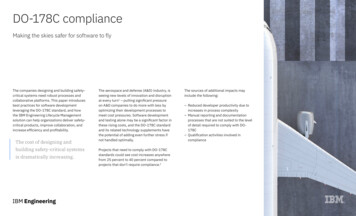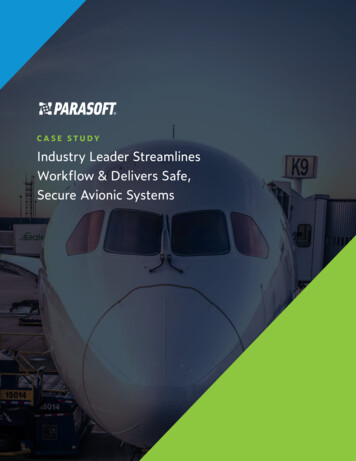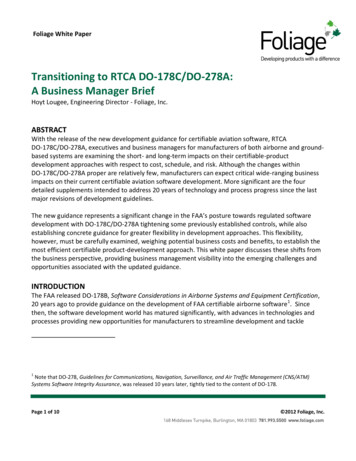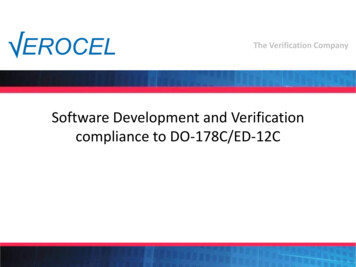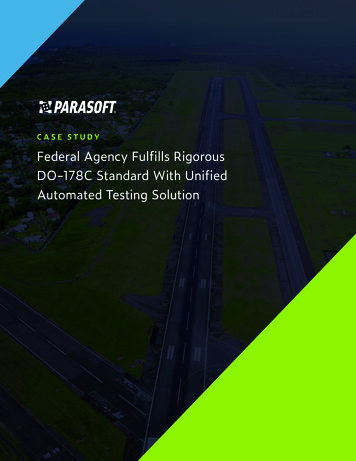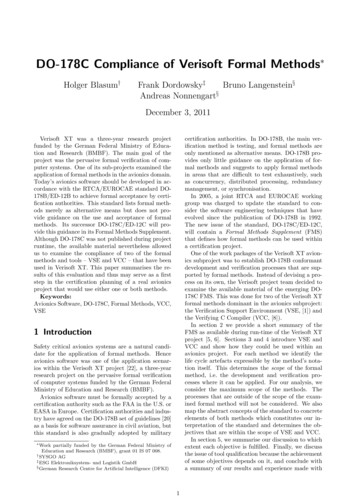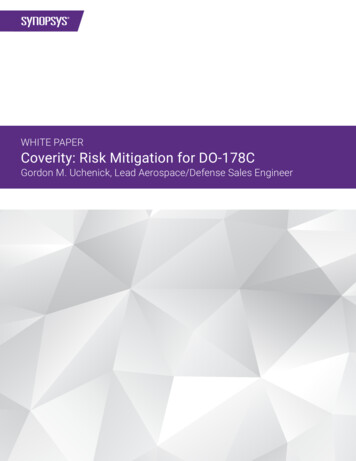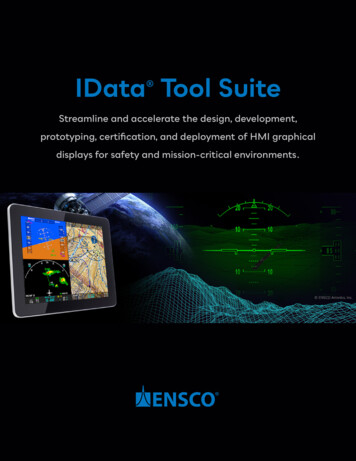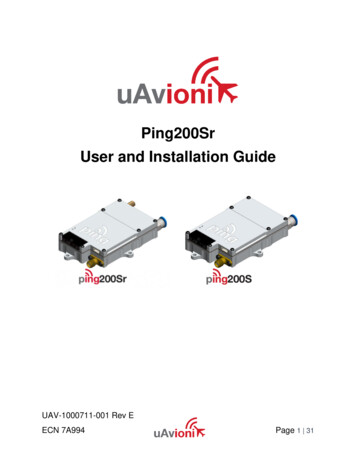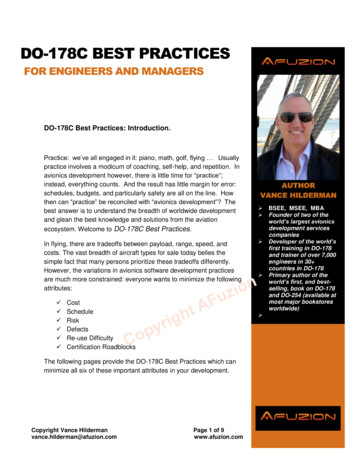
Transcription
DO-178C BEST PRACTICESFOR ENGINEERS AND MANAGERSDO-178C Best Practices: Introduction.Practice: we’ve all engaged in it: piano, math, golf, flying Usuallypractice involves a modicum of coaching, self-help, and repetition. Inavionics development however, there is little time for “practice”;instead, everything counts. And the result has little margin for error:schedules, budgets, and particularly safety are all on the line. Howthen can “practice” be reconciled with “avionics development”? Thebest answer is to understand the breadth of worldwide developmentand glean the best knowledge and solutions from the aviationecosystem. Welcome to DO-178C Best Practices.In flying, there are tradeoffs between payload, range, speed, andcosts. The vast breadth of aircraft types for sale today belies thesimple fact that many persons prioritize these tradeoffs differently.However, the variations in avionics software development practicesare much more constrained: everyone wants to minimize the followingattributes: CostScheduleRiskDefectsRe-use DifficultyCertification Roadblocks The following pages provide the DO-178C Best Practices which canminimize all six of these important attributes in your development.Copyright Vance Hildermanvance.hilderman@afuzion.comAUTHORVANCE HILDERMANPage 1 of 9www.afuzion.comBSEE, MSEE, MBAFounder of two of theworld’s largest avionicsdevelopment servicescompaniesDeveloper of the world’sfirst training in DO-178and trainer of over 7,000engineers in 30 countries in DO-178Primary author of theworld’s first, and bestselling, book on DO-178and DO-254 (available atmost major bookstoresworldwide)
DO-178C Best Practices – Vance HildermanDO-178C Best Practices: PreludeCertain good avionics software development practices are self-evident. Similar to improvinghuman health, educated persons know that improved diet, exercise, sleep, and stress relief are all“best practices”. For software, the obvious good practices include utilizing defect prevention,experienced developers, automated testing, and fewer changes. This paper isn’t about theobvious, as it is assumed the reader is educated by virtue of making it to this page. Instead, theDO-178C Best Practices identified herein are subtler and considerably “less practiced”.The following figure summarizes the Top 10 not-always-obvious DO-178C Best Practices:1. Improved LLR Detail2. Parallel Test Case Definition3. Implement Testing Standards4. Model Framework Templates5. Fewer, but Better, Reviewers6. Automated Regression & CBT7. Automated Design Rule Checker8. Advanced Performance Testing9. Parallel Traceabilty/Transition Audits10. Technical Training WorkshopsTop 10 Not-Always-Obvious DO-178C Best Practices2Copyright Vance m
DO-178C Best Practices – Vance Hilderman1. Improved LLR DetailRequirements are the foundation to good engineering. Detailed requirements are the foundationto great engineering.”Smarter researchers than this author long ago proved that most software defects are due to weakrequirements. In the book Mythical Man Month, Brooks opined that assumptions were a leadingcause of software defects. DO-178C was intentionally strengthened over its predecessor DO178B to ensure acceptable requirements via 178C’s mandate to trace structural coverage analysisto requirements-based tests (RBT). Remember: DO-178C doesn’t provide strict requirementsstandards, but for DAL A, B, and C, the developer must. Those standards should define thescope and detail associated with High-Level Requirements (HLR’s) and Low-Level Requirements(LLRs). Ideally the Requirements Standard will include examples of HLR’s versus LLR’s.Requirements review checklists should likewise contain ample criteria for evaluating the level ofdetail within low-level requirements.2. Parallel Test Case DefinitionIf a Tester cannot unambiguously understand the meaning of a software requirement, how couldthe developer?DO-178C is agnostic regarding cost and schedule: the developer is freely allowed to be behindschedule and over budget. While transition criteria must be explicitly defined for all softwareengineering phases, it is normal for companies to define their test cases after the software iswritten. However, great companies define test cases before code is written. Why? Because it’sbetter to prevent errors than detect them during testing. If a Tester cannot unambiguouslyunderstand the meaning of a software requirement, how could the developer? Good companiesverify requirements independently by having the software tester define test case as part of therequirements review, before any code is written. Requirements ambiguities or incompleteness arecorrected earlier, yielding fewer software defects and expedited testing.3. Implement Testing StandardsRequirements Standard. Design Standard. Coding Standard. Testing Standard Wait, there ISN’T a Testing Standard?!?3DO-178C explicitly requires standards for DAL A, B, and C. Which standards? Requirements,Design, and Code. Why doesn’t DO-178C require a verification or testing standard? Supposedlythere should be less variation within testing, compared to the preceding lifecycle phases which areadmittedly more variable between companies and projects. No one has ever accused DO-178C ofrequiring too few documents; given the traditional waterfall basis (inherited two decades prior fromCopyright Vance m
DO-178C Best Practices – Vance HildermanDO-178A), ample documents are required already. However, efficient companies recognize thatverification is an expensive and somewhat subjective activity best managed via a Software TestStandard. Since not formally required, it would not have to be approved or even submitted. Whatwould such a hypothetical Software Test Standard cover? At a minimum, the following: Description of RBT to obtain structural coverage;Details regarding traceability granularity for test procedures and test cases;Explanations of structural coverage assessment per applicable DAL(s);Definition of Robustness testing, as applied to requirements and code (perapplicable DALs);If DAL A, explanations of applicable MCDC and source/binary correlation;Coupling analysis practices including role of code and design reviews;Performance based testing criteria; andExamples of requirements and code, along with recommended associated testcases.4. Model Framework TemplatesSoftware modeling will eventually fade away when software functionality, complexity, and sizeall decrease 90%.There are few safe bets in life, however this author claims continually increasing softwarefunctionality, complexity, and size are all safe bets. As exercise will help manage a high-fat diet,software modeling better manages tomorrow’s software. However, models and modelingtechniques can vary greatly. Large variation within a project defeats much of the benefit ofmodeling, particularly within verification and re-use. Best practice? Use model frameworks andspecify these in the project’s Design Standard. Independently review these frameworks to explicitcriteria (using a checklist), control them, and require their usage.5. Fewer But Better ReviewersOne Great reviewer is better than many Good reviewers.If More equaled Better, airplanes would have ten engines This author has never seen a ten-engine airplane, but he’s seen many peer review teams with tenengineers. Why so many reviewers? Was it Optimism? Pragmatism? Perhaps simple Naivety:human nature is replete with “more is better” examples. However, in the case of software reviews,one great reviewer is the better choice. One great reviewer is more cost-effective, moreproductive, and with proper skill, better. When a rowboat is paddling away from an incomingtorpedo, one oarsman will work harder than many – human nature is human and human reviewers4Copyright Vance m
DO-178C Best Practices – Vance Hildermanperform better when they know they are the sole reviewer. A common gap in DO-178C is weakreviews; a proper review must be shown to meet DO-178C’s transition criteria, meaning the sixrequired inputs to, for example, a code review are all fully utilized for all code reviews. Engineers(the “Reviewer”) must use all these review inputs which must be specified in the Verification Planand then Quality Assurance audits affirm that this process is followed by the verification engineer.(For more information on DO-178C Gap Analysis plus a one-minute video, see here:http://afuzion.com/gap-analysis/ ).6. Automated Regression & CBTIn the non-critical software world, testing is a “great idea”. Purchasing an exotic car or yacht canalso seem like a great idea at acquisition time, as this author has personally experienced.However, unlike luxury cars and yachts, software testing should not be considered a luxury butrather a necessity. DO-178C requires a variety of necessary testing, with increased rigor perincreased criticality. The basic types of testing are depicted below:DO-178C requires regression analysis whereby software updates are assessed for potentialimpact to previously tested software with mandatory retest required where potential impact exists.Over the project life, and absolutely over the product life, more time will be spent on testing thanon development. Many consider software testing to be the largest line-item expense in DO-178C.Devoting upfront time to develop a test automation framework can provide the single largestexpense reduction ability. And continuous-based testing (CBT), which automatically retestschanges continuously, is the best means to meet regression objectives. Why? By continuouslyretesting all software the regression analysis is greatly simplified: just repeat all the tests bypressing a button. Voilà.5Copyright Vance m
DO-178C Best Practices – Vance Hilderman7. Automated Design Rule CheckerOn their best days, humans perform satisfactorily when checking software design rules; in thesafety-critical world, not all days are best days.The safety-critical software world is replete with tools and techniques for performing static codeanalysis, automating testing, structural coverage, and model-based design. Wonderfully helpful,even necessary. However, if an imperfection can be considered a defect, then theaforementioned activities miss an entire area of defective design. Consider: a leading cause ofsoftware defects is “assumptions”, hence the need for detailed requirements, traceability, codingstandards, etc. However, different humans have different “assumptions” regarding softwaredesign and internal interfaces. These different assumptions yield imperfectly coordinated softwarecomponents and these imperfections may mask defects. The remedy? Automated design rulecheckers which help ensure consistent, deterministic interfaces and execution. Combined with themodel framework templates of #4 above, a most powerful combination results.8. Advanced Performance TestingWould you want to buy a new car model which has never been tested in aggressive drivingconditions? I live in Los Angeles and Manhattan; me neither.Interestingly, DO-178C provides very little guidance on performance testing so a common pitfallensues: minimal software performance testing. However, thorough performance testing is ahallmark of quality software and the only means to find certain defects which otherwise are notdetected until potentially catastrophic in-flight failures. Often correcting performance relatedsoftware defects entails major architectural changes, which are always time-consuming andexpensive. A better way? Advanced performance testing which fully: Defines worst-case loads, with worst-case execution times (WCET)Utilizes continuous maximal rate of change for inputs across all interfacesVerifies the separate DO-178C-mandated discrete performance requirementsConsider degraded-mode operations where primary inputs are not availablemandating using of more computationally intensive secondary inputs Utilizes worst-case Parameter Data Items (PDI’s) where each PDI is deliberatelychosen for WCET impact.6Copyright Vance m
DO-178C Best Practices – Vance Hilderman9. Parallel Traceability/Transition Audits“Why do it right the first time when it’s fun to keeping doing it over and over ” – AnonymousWhere the amateur athlete focuses on the end result, the professional instead focuses uponoptimizing the technique since the end result depends upon that technique. Amateur andprofessional software engineers both know minimizing defects is a goal, but the professionalknows that technique matters: in avionics that is best summarized via DO-178C’s traceability andtransition criteria. While the amateur avionics team assesses traceability and transition criteria atthe end, e.g. SOI-4, the experienced team instead deploys proactive SQA and tools to monitor bidirectional traceability continuously. Emphasize audits of transition criteria early, fix processshortfalls, and record the audit results. Remember, each type of artifact review constitutes a“transition”: engineers must follow the defined transition criteria and QA must audit to assessprocess conformance. An example of a Software Code Review transition is depicted below:ensure all the inputs and outputs are perfectly utilized, under CM, and referenced in the results:10. Technical Training WorkshopsRegardless of profession, the ingredients for becoming the “best” include a combination of1) education, 2) coaching, and 3) practice. Avionics groups employing Best Practices address thefirst two ingredients via training. Whether procured internally or externally, the odds of DO-178Csuccess can be enhanced via technical training. Which training? Best to focus on areas of highreturn-on-investment including improved productivity and consistency in: Requirements writing (emphasize consistent medium granularity for consistency) Software Testing (emphasize thoroughness, full real-world scenarios which exercisecross-domain interfaces) Reviews (emphasize standard, detail, robustness, changes) – identify meaningfuldefects. Auditing (emphasize Transition Criteria process) and finding/fixing actual defects7Copyright Vance m
DO-178C Best Practices – Vance HildermanFor Advanced DO-178C Training information, see: http://afuzion.com/training/For DO-178C Gap Analysis information & video, see: http://afuzion.com/gap-analysis/What is AFuzion? Fun One-Minute Video: https://www.youtube.com/watch?v RMzLRzcahJEFor DO-178C & DO-254 specific details, procure the book “Avionics Certification: A CompleteGuide To DO-178C & DO-254”, from major bookstores such as Amazon.com. (The author of thiswhitepaper is the primary author of that book.) Also, the new book “Avionics DevelopmentEcosystem” by Vance Hilderman covers the big-picture view of avionics development from safety,to systems, and through all key regulatory and design aspects for modern avionics development.See the Afuzion website, www.afuzion.com, for advanced training modules relevant to DO-178Cbeginners and experts alike.AFuzion’s Worldwide Onsite Engineering Footprint - When Safety Is Critical TM:8Copyright Vance m
DO-178C Best Practices – Vance Hilderman9Copyright Vance m
cause of software defects. DO-178C was intentionally strengthened over its predecessor DO-178B to ensure acceptable requirements via 178C's mandate to trace structural coverage analysis to requirements-based tests (RBT). Remember: DO-178C doesn't provide strict requirements standards, but for DAL A, B, and C, the developer must.
